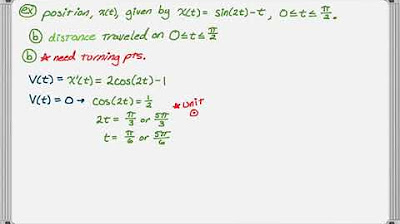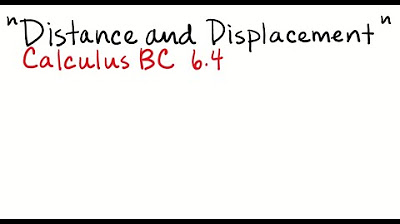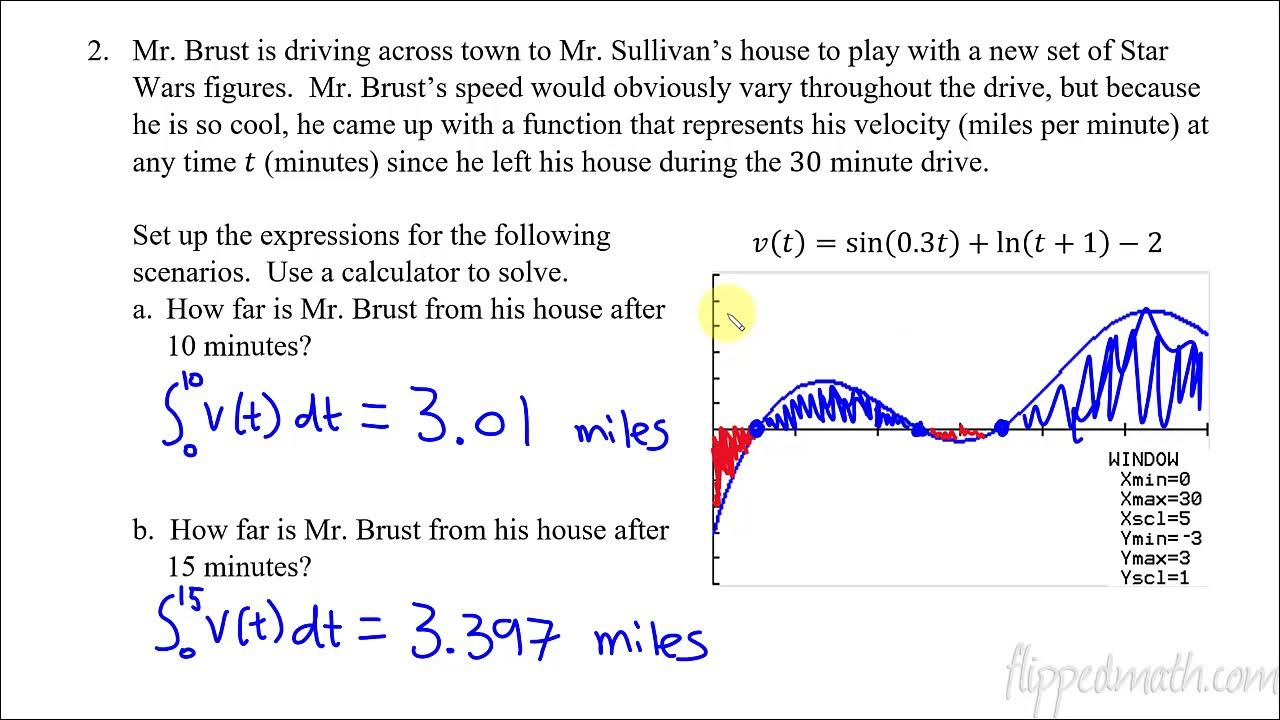Displacement and Distance Traveled On Calculator
TLDRThe video script outlines a comprehensive approach to solving a physics problem involving a position function s(T) = T^3 - 4T^2 + 2T + 1. The task is to calculate the displacement and distance traveled on the interval from 0 to 5. The presenter simplifies the process by using a calculator, first finding the displacement by evaluating s(5) - s(0), which results in a positive 35 units. For the more complex distance traveled, the presenter graphs the velocity and finds its derivative to identify turning points within the interval. By storing these points as 'a' and 'b', the presenter calculates the absolute value of the displacement for each segment (0 to a, a to b, and b to 5) and sums them to find the total distance traveled, which is 44.370 units. The video provides a step-by-step guide, emphasizing the difference between displacement and distance, and demonstrates the use of a graphing calculator to solve the problem efficiently.
Takeaways
- 📌 The problem involves finding the displacement and distance traveled on the interval from 0 to 5 for a given position function s(T) = T^3 - 4T^2 + 2T + 1.
- 🔍 Displacement is calculated by finding the final position s(5) and subtracting the initial position s(0), resulting in a displacement of 35 units.
- 🚀 To find the distance traveled, it's necessary to consider the entire path taken, including any turns or changes in direction.
- 📈 The velocity function is derived from the position function by differentiating it with respect to time (T).
- 🧮 The derivative is set to zero to find the points where the direction of motion changes (turning points) within the interval 0 to 5.
- 📊 A graph of the velocity function is used to visualize and confirm the turning points are within the interval.
- 🔑 The turning points are stored for reference, allowing for the calculation of displacement on each segment of the path.
- ➡️ The distance traveled is calculated by summing the absolute values of the displacements between the turning points and the endpoints.
- 🔢 The final calculated distance traveled is approximately 44.370 units.
- 💡 The process involves using a graphing calculator to solve for the turning points, graph the derivative, and perform the necessary calculations.
- ✅ The video provides a step-by-step guide on how to approach and solve problems involving displacement and distance traveled, emphasizing the use of a calculator for efficiency.
- 📝 Storing values and using the calculator's graphing and storage features are highlighted as efficient methods for solving complex problems.
Q & A
What is the position function given in the video?
-The position function given in the video is s(T) = T^3 - 4T^2 + 2T + 1.
What is the interval for which the displacement is to be found?
-The displacement is to be found on the interval from T = 0 to T = 5.
What does the displacement represent?
-Displacement represents the final position relative to the starting position, indicating how far and in which direction the object has moved over the given interval.
How is the displacement calculated?
-Displacement is calculated by finding the value of the position function at the end point of the interval and subtracting the value of the position function at the starting point, that is, s(5) - s(0).
What is the result of the displacement calculation?
-The displacement is found to be 35 units to the right of where the object started.
What is the difference between displacement and distance traveled?
-Displacement is the straight-line distance between the start and end points, while distance traveled is the total length of the path taken by the object, including all changes in direction.
How is the distance traveled calculated?
-Distance traveled is calculated by summing the absolute values of the displacements over each segment of the path where the direction of motion changes.
What is the first step in finding the distance traveled?
-The first step is to find the derivative of the position function to determine the velocity and identify points where the direction of motion changes, which are the points where the velocity is zero.
How does the video script handle the calculation of distance traveled?
-The script calculates the distance traveled by finding the derivative of the position function, determining where it equals zero to find turning points, and then summing the absolute values of the displacements between those points and the endpoints of the interval.
What is the final result for the distance traveled?
-The distance traveled on the interval from T = 0 to T = 5 is calculated to be 44.370 units.
What tools or methods does the video script suggest for solving these problems?
-The video script suggests using a calculator page for direct calculations and a graph page for visualizing the derivative and identifying turning points.
How does the video script demonstrate the process of solving the problems?
-The script demonstrates the process by showing how to input the position function, calculate the derivative, solve for points where the derivative equals zero, and then use these points to calculate the displacement and distance traveled.
Outlines
📐 Solving Displacement and Distance with Position Function
This paragraph introduces the problem of finding displacement and distance traveled using a given position function s(T) = T^3 - 4T^2 + 2T + 1 over the interval from 0 to 5. The presenter explains the process of using a calculator to solve for displacement, which is the final position minus the initial position (s(5) - s(0)), resulting in a displacement of 35 units to the right. The distance traveled is more complex, as it involves finding where the object changes direction within the interval. The presenter outlines the steps to find the derivative of the position function to determine velocity and then solve for when this velocity is zero, indicating a change in direction.
📈 Calculating Distance with Stored Values and Graphing
The second paragraph delves into calculating the distance traveled by first finding the derivative of the position function and solving for when it equals zero to find turning points within the interval from 0 to 5. The presenter then graphs the derivative function, stores the turning points as variables A and B, and uses these to calculate the distance. The process involves summing the absolute values of displacements between the points 0 to A, A to B, and B to 5. By using the calculator and graphing tools, the presenter determines the distance traveled to be 44.370 units. The explanation highlights the difference between displacement and distance, noting that while conceptually similar, distance is more challenging to compute due to the need to account for direction changes.
Mindmap
Keywords
💡Displacement
💡Distance Traveled
💡Position Function
💡Velocity
💡Derivative
💡Graphing
💡Interval
💡Absolute Value
💡Calculator
💡Roundoff
💡Direction Change
Highlights
The video aims to solve a problem involving a position function and finding displacement and distance traveled on a given interval.
The position function s(T) is given as T^3 - 4T^2 + 2T + 1.
Displacement is calculated by finding the difference between the final and initial position, s(5) - s(0).
The displacement from 0 to 5 is found to be 35 units to the right or above the starting point.
Distance traveled is a more complex calculation that requires understanding the path taken, including any turns or changes in direction.
Velocity is derived from the position function to understand the motion over time.
The derivative of the position function is found using the power rule.
Solving the derivative equal to zero helps identify points of change in direction within the interval.
Two points, A and B, are found where the derivative equals zero and are within the interval from 0 to 5.
A graph of the velocity function is used to visualize and understand the motion better.
The graph page is used to store and label the points A and B for further calculations.
Distance traveled is calculated by summing the absolute values of displacements between points 0 to A, A to B, and B to 5.
The final calculated distance traveled on the interval from 0 to 5 is 44.370 units.
The process involves using a calculator for complex mathematical operations and graphing for visual representation.
The video demonstrates efficient use of calculator functions and graphing to solve the problem in a short amount of time.
Storing values and using the calculator's menu options streamline the process of solving for displacement and distance.
The video concludes by emphasizing the difference in complexity between displacement and distance traveled, with distance being more challenging to calculate.
The presenter expresses the hope that the viewers found the explanation helpful for understanding the problem-solving process.
Transcripts
Browse More Related Video

Distance and Displacement using Position and Velocity

2023 AP Calculus AB FRQ #2

Distance and Displacement

Distance and displacement in one dimension | One-dimensional motion | AP Physics 1 | Khan Academy

Calculus AB/BC – 8.2 Connecting Position, Velocity, and Acceleration of Functions Using Integrals

Displacement and Velocity - How is it different from Distance and Speed? | Physics
5.0 / 5 (0 votes)
Thanks for rating: